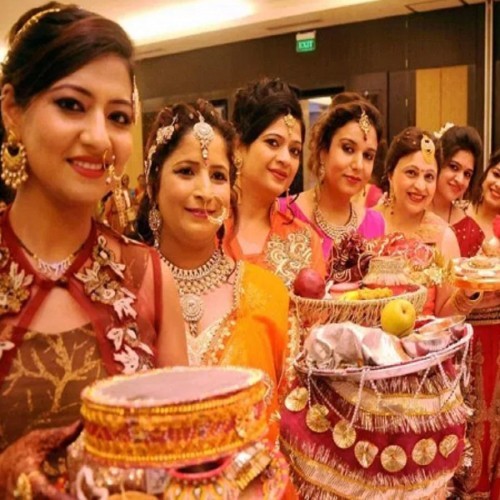The festival when women fast, often nirjala, from sunrise to moonrise, as a penance for the husband’s long and healthy life. This is followed by the hoyi mata fast, again a day long penance for the son’s health and wellbeing. Post these two fasts, the women get into the zone of Diwali cleaning and spurring up the house, shopping, standing long hours in the kitchen cooking for the festivities, etc. It is exactly in this month that all my beautiful, sensible women who have been enjoying effortless periods complain of cramps, breakouts and fatigue.
My team and I then tell them that its because of Karva chauth and they laugh it off thinking its probably coming out of my “feminist” view than any real thing. However, the practice of Karva chauth in its current form is a threat to the wellbeing of the entire family, because the belief is that if the woman is sick and down, so is the family. And look around, this is the month when women in your household, especially the ones who follow the Karva chauth, Hovi mata tradition, fall ill from mild fatigue, throat infections to full blown fevers and upset stomachs.
From the nutrition point of view, I will tell you what happens starting with karva chauth. For starters I have no idea what text or Purana this practice belongs to, I believe its more of an oral tradition, which means that as women who belong to cultures which follow oral tradition, we must keep the confidence and sensibility to tweak the practice to retain the essence and ease out the ritual to fit into our current lives.
The practice of basking in the moon light in the month of kartik should be retained as this is the time when the moon emits rays with curative and anti-ageing properties. As a couple (karvachauth), family and friends (Kojagiri), Parent- child (Hovimata) when we bask in this moon light, we ensure that all of us receive the moon’s blessings to live longer and healthier (curative and anti-ageing). This resonates in the ‘Sarve bhavantu sukhinaha’ tradition, the foundation of the Indian culture. The moon also depicts the ‘water’ element of the pancha mahabhut (air, water, earth, space, fire) of the Indian philosophy. And exposure to the Moon allows the body to harmonize its water balance.
If you notice, post Diwali is when skins go dry, lips crack and grandmothers complain of weak knees, all of this in Ayurved is linked to loss or imbalance of the water element and increase in the dryness or the ‘Vata’ element. The karva chauth practice is meant as a protection against these too. Since winters are harsher in the North, this practice is prevalent amongst the North Indian communities.
Now what does the doctor tell you when she prescribes you a medicine? Eat something before you take it, right? Why? Because when blood sugars are steady the body can take the drug or the medicine and deliver it to the cells where it will actually carry out its repair or cure work. Without steady blood sugar levels, the drug will not be able to carry out its work optimally and exaggerate its side effects, right? Now simply apply this understanding to the KC fast. How can you possibly use the curative, anti-ageing properties of the moon on a hypoglycemic state? You can’t! So we need to reinvent this practice.
Here’s what we can do on the karva chauth day to optimize our time in the moon –
- Avoid waking up before sunrise to eat.
- Wake up at sunrise or your usual time and start your day with a Banana or a handful of dry fruits
- Eat Rajgeera or a kuttu roti for breakfast
- Sweet potato and dahi for lunch
- Fresh fruit milkshake for an evening snack
- Enjoy a light dinner or some makhana before moonrise
- Spend some good time up on the roof/ terrace/ balcony – thank your stars, nature and the moon for the many miracles they silently bestow upon you.
- Feel grateful for the company you have – spouse, parents, children, family, friends
- Acknowledge the fact that man must live in harmony with her/ his surroundings
- Enjoy a delicious meal post moonrise with one and all
If you notice, all except the last meal have options from foods that are “allowed”, actually recommended on a Upavas or a fasting day. KC is probably the only fast where women eat food both before sunrise and sunset that are otherwise “not allowed” on a fast day.
We must acknowledge that all of the fasting foods have been recommended in our tradition after thorough research of centuries, after observing the health of women (who maintain delicate hormonal balance) on days that they choose to go without or with little food.
It is in our interest to follow these rules on days we fast whether it is for the son or the husband or anyone else. Also make sure that husband and son help with all the cleaning, cooking, etc., that follows these two fasts as we enter Diwali. I mean what’s the use of their long, healthy life if they can’t contribute in our daily and Diwali chores?;)
Courtesy: http://rujutadiwekar.blogspot.in/









